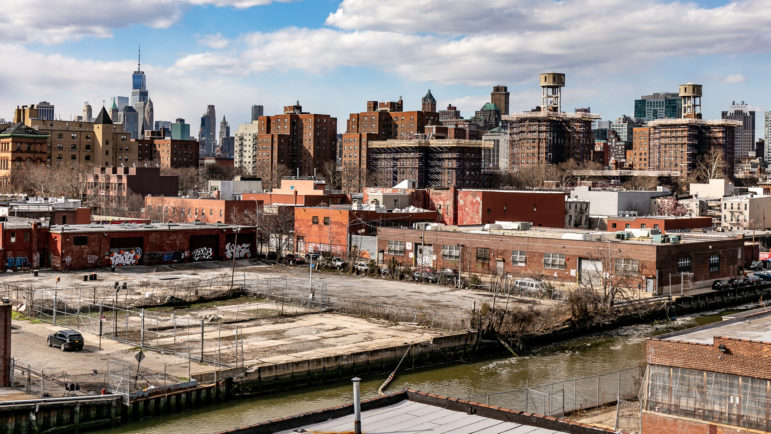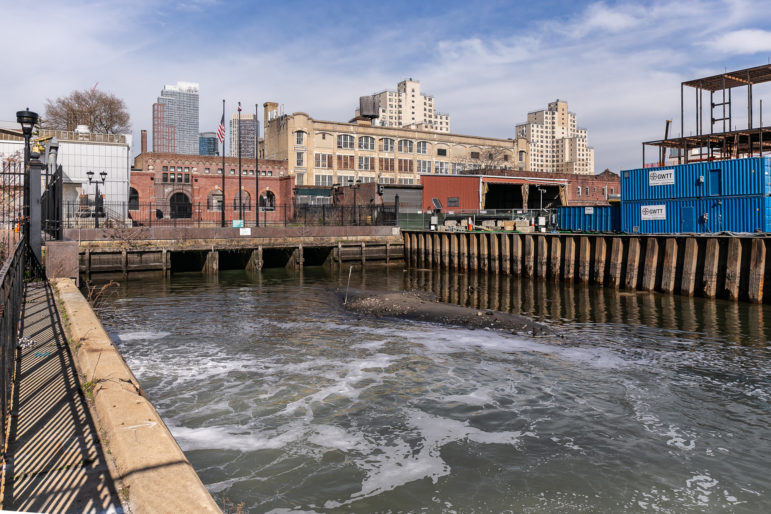“This is the biggest rezoning this administration has done over our eight years,” the mayor said ahead of Tuesday’s vote on the plan, which will upzone an 82-block swath of the Brooklyn neighborhood to add an estimated 8,500 new apartments.

Adi Talwar
The western shore of Gowanus Canal between Sackett, Degraw and Douglass Streets.The New York City Council on Tuesday approved a plan to upzone an 82-block swath of Gowanus, delivering a late-term land use victory for Mayor Bill de Blasio and paving the way for a long-debated transformation of the Brooklyn neighborhood.
The Council voted 47 to 1 in favor of the rezoning plan, which the de Blasio Administration estimates will add 8,500 new apartments to the neighborhood by 2035. About 3,000 of those units—including roughly 950 in a development planned for the city-owned Public Place site—would be considered “affordable,” or reserved for people making a percentage of area median income under the city’s Mandatory Inclusionary Housing (MIH) program.
“This is the biggest rezoning this administration has done over our eight years,” said de Blasio, who has made rezoning neighborhoods for greater density a core element of his housing approach during his two terms in office. “This is exactly the kind of thing we came here to do,” he said Tuesday in a press conference ahead of the vote.
The rezoning approval, with Councilmember Carlos Menchaca as the lone “no” vote, comes after more than a decade of proposals and planning sessions for remaking Gowanus, which began under de Blasio’s predecessor Michael Bloomberg. The final plan continues to encounter intense resistance from neighborhood groups who cite concerns over the future of toxic land, Gowanus Canal sewage overflow, the changing character of the neighborhood and the ability to make good on affordable housing targets.
The proposal faced little resistance from local leaders, however.
Councilmember Brad Lander, who represents most of the rezoned area, and Councilmember Stephen Levin have for months expressed their support for the plan, though they said their final approval depended on a number of concessions by the city—most notably, a commitment to funding about $200 million in renovations at the Gowanus Houses and Wyckoff Gardens Houses. They announced their formal endorsement of the plan earlier this month after the city committed to many of their demands, including plumbing, wall and other interior repairs at every apartment in the two NYCHA campuses, outlined in a 21-page “points of agreement” package.
“The Gowanus Neighborhood Rezoning shows that it is possible for New Yorkers to plan together for a more inclusive and sustainable future of our city,” Lander said before the vote Tuesday. “It shows many people will accept growth in their neighborhood if they are part of the planning process.”
In comments before the full Council, Levin hailed the NYCHA commitments. “Every single apartment is going to be refurbished by NYCHA—not by RAD or private development…which is extraordinary and unprecedented and for aging infrastructure, this will give them a longer life.”
The rezoning was also backed by the City Planning Commission, Brooklyn Borough President Eric Adams—the mayor-elect—and Brooklyn’s Community Board 6, which also made its support contingent on the NYCHA funding. Brooklyn Community Board 2, which represents a portion of the rezoning area, voted against the plan in June.
The land use changes will cover the area bound by Bond Street to the west, 4th Avenue to the east, Baltic Street to the north and Huntington, 3rd, 7th and 15th streets to the south. The plan will allow towers up to 30 stories tall near the Gowanus Canal and around 17 stories -tall along 4th Avenue.
The Gowanus rezoning marks the first time that de Blasio sought and received approval for a neighborhood-level upzoning in a predominantly white community where resident incomes exceed the citywide average. Opponents have contested that characterization of the demographic makeup of the proposed rezoning area, but a review of overlapping census tracts in the City Planning Department’s “Population FactFinder” database seems to support the city’s contention. Another land use proposal under review, and approaching a final Council vote, would upzone a large portion of SoHo and NoHo, among the city’s wealthiest communities.
Unlike other de Blasio era rezonings, plan supporters say, MIH will actually create units affordable to people who earn less than the average income in Gowanus. In past plans, like the rezoning of East New York, MIH units were still unaffordable to many local residents, according to a study released earlier this year by the Association for Neighborhood and Housing Development.
The Gowanus plan was also the first to undergo an independent racial impact study, which found that the rezoning would increase income and racial diversity in the neighborhood. The City Council voted in June to make racial impact studies mandatory starting in 2022.
The points of agreement package specifically describes the city’s commitment to 100 percent affordable housing at the Public Place site, a large city-owned property undergoing environmental remediation to remove toxic coal tar.

Adi Talwar
A view of the Northern end of Gowanus Canal.The planned development, which will be called Gowanus Green, will feature 950 units, with at least 50 percent of apartments reserved for New Yorkers earning 50 percent of AMI or below ($41,800 for a single person and $59,650 for a family of four). Another 40 percent of the apartments will be set aside for people earning between 80 percent and 120 percent of AMI (between $66,880 to $100,320 for an individual and $95,440 to $143,160 for a family of four). The final breakdown has not yet been determined, but 5th Avenue Committee Executive Director Michelle De La Uz, a former City Planning commissioner, said the low-income units will likely account for 60 percent of the apartments. The city also pledged to develop 115 units for seniors, about 73 units as supportive housing and about 67 units as condos at the site.
Opponents of the plan have repeatedly assailed the feasibility of the city’s environmental pledges at Public Place and along the polluted Gowanus Canal. They have also questioned whether the city will actually uphold its affordable housing commitments, pointing to the unfulfilled pledges of previous rezonings.
The city’s plan “would place low-income and homeless families on forever-toxic land that must be monitored for cancer-causing fumes in perpetuity,” the group Voice of Gowanus, which has opposed the rezoning plan, wrote in a letter to councilmembers ahead of a land use committee vote earlier this month. “This is where the only 100% affordable development is planned—on this most highly toxic land—and it makes up less than 3% of the entire 200-acre rezone.”
They joined U.S. Rep. Nydia Velázquez in September to demand that the city redo a Draft Environmental Impact Statement (DEIS) for the rezoning, saying the current DEIS was based on outdated rainfall data from 2008 and fails to account for the worsening impact of climate change and extreme weather events like Hurricane Ida. They also challenged the city’s contention that there will be “net-zero” combined sewage overflow (CSO) into the polluted Gowanus Canal as a result of rezoning-related construction.
Another piece of legislation approved by the Council Tuesday will force the city to report on the progress toward its Gowanus rezoning commitments and neighborhood changes—though that will take awhile. The bill requires the Department of City Planning to study and report on changes in population and housing that have occurred in the 14 years since a Council-approved land use project took effect, going back to 2009.
The Gowanus plan now goes before de Blasio for final approval.










One thought on “NYC Council Approves de Blasio’s Massive Gowanus Rezoning”
8500 new apartments (approx 20,000 new residents) in a neighborhood with 120 year old water mains and sewers. LOL!